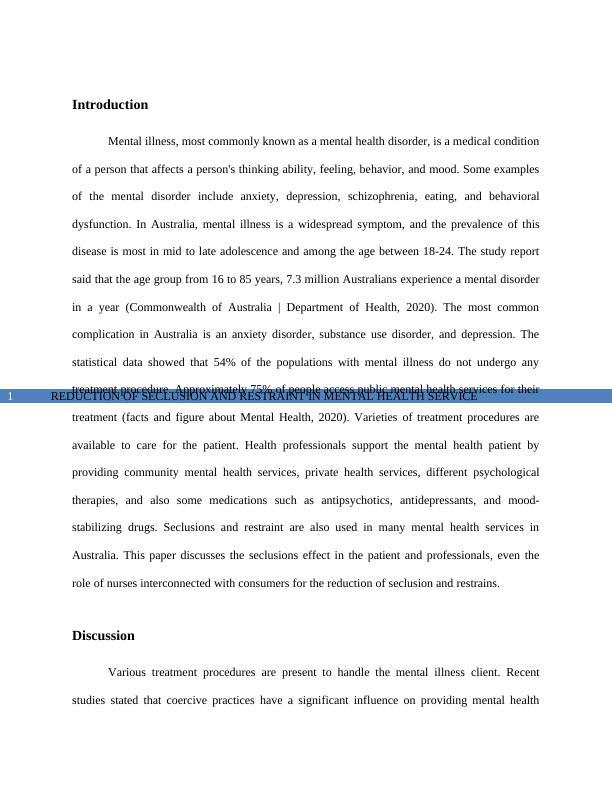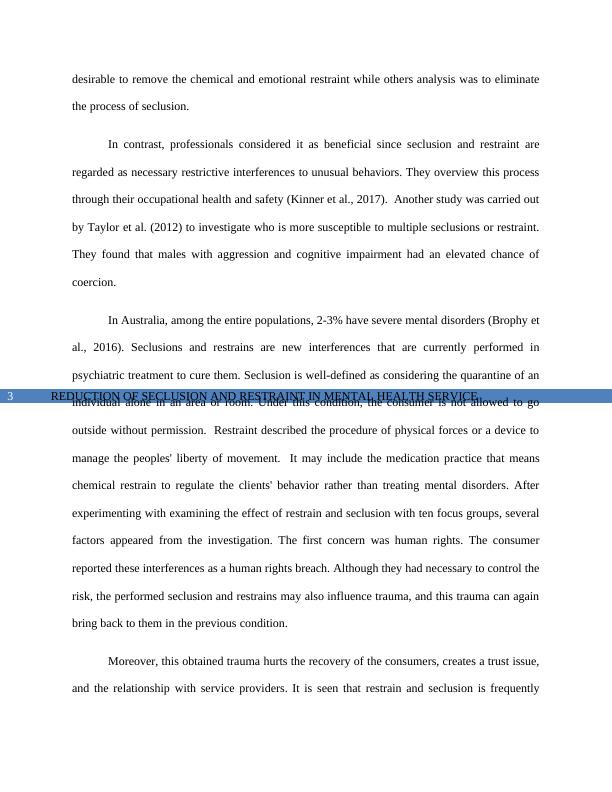Essentials of Psychiatric Mental Health Nursing
Added on 2022-08-24
12 Pages3388 Words22 Views
Running head: REDUCTION OF SECLUSION AND RESTRAINT SERVICES
REDUCTION OF SECLUSION AND RESTRAINT SERVICES
Name of the Student
Name of the University
Author Note
REDUCTION OF SECLUSION AND RESTRAINT SERVICES
Name of the Student
Name of the University
Author Note

REDUCTION OF SECLUSION AND RESTRAINT IN MENTAL HEALTH SERVICE1
Introduction
Mental illness, most commonly known as a mental health disorder, is a medical condition
of a person that affects a person's thinking ability, feeling, behavior, and mood. Some examples
of the mental disorder include anxiety, depression, schizophrenia, eating, and behavioral
dysfunction. In Australia, mental illness is a widespread symptom, and the prevalence of this
disease is most in mid to late adolescence and among the age between 18-24. The study report
said that the age group from 16 to 85 years, 7.3 million Australians experience a mental disorder
in a year (Commonwealth of Australia | Department of Health, 2020). The most common
complication in Australia is an anxiety disorder, substance use disorder, and depression. The
statistical data showed that 54% of the populations with mental illness do not undergo any
treatment procedure. Approximately 75% of people access public mental health services for their
treatment (facts and figure about Mental Health, 2020). Varieties of treatment procedures are
available to care for the patient. Health professionals support the mental health patient by
providing community mental health services, private health services, different psychological
therapies, and also some medications such as antipsychotics, antidepressants, and mood-
stabilizing drugs. Seclusions and restraint are also used in many mental health services in
Australia. This paper discusses the seclusions effect in the patient and professionals, even the
role of nurses interconnected with consumers for the reduction of seclusion and restrains.
Discussion
Various treatment procedures are present to handle the mental illness client. Recent
studies stated that coercive practices have a significant influence on providing mental health
Introduction
Mental illness, most commonly known as a mental health disorder, is a medical condition
of a person that affects a person's thinking ability, feeling, behavior, and mood. Some examples
of the mental disorder include anxiety, depression, schizophrenia, eating, and behavioral
dysfunction. In Australia, mental illness is a widespread symptom, and the prevalence of this
disease is most in mid to late adolescence and among the age between 18-24. The study report
said that the age group from 16 to 85 years, 7.3 million Australians experience a mental disorder
in a year (Commonwealth of Australia | Department of Health, 2020). The most common
complication in Australia is an anxiety disorder, substance use disorder, and depression. The
statistical data showed that 54% of the populations with mental illness do not undergo any
treatment procedure. Approximately 75% of people access public mental health services for their
treatment (facts and figure about Mental Health, 2020). Varieties of treatment procedures are
available to care for the patient. Health professionals support the mental health patient by
providing community mental health services, private health services, different psychological
therapies, and also some medications such as antipsychotics, antidepressants, and mood-
stabilizing drugs. Seclusions and restraint are also used in many mental health services in
Australia. This paper discusses the seclusions effect in the patient and professionals, even the
role of nurses interconnected with consumers for the reduction of seclusion and restrains.
Discussion
Various treatment procedures are present to handle the mental illness client. Recent
studies stated that coercive practices have a significant influence on providing mental health

REDUCTION OF SECLUSION AND RESTRAINT IN MENTAL HEALTH SERVICE2
services. Consumer responses varied rapidly in obtaining the services as cultural factors involved
in this. The study reported that African-American consumers experienced a low level of coercive
practices compared to Latinos and Whites. They were treated differently from others. The study
results suggested that the consumer did not consider the low-end coercive strategies as coercion
(Luciano et al., 2014). The absenteeism of a connection between strategy utilization and received
pressure noted that consumers interpreted the behavior of caregivers differently.
Consequently, the relationship is dependent upon the users' perception of coercion
regardless of the caregivers' behavior. The study also revealed the negative relationship persists
between caregiver-consumer relationships and observed constraints (Theodoridou et al., 2012).
Coercive practices are always a part of mental illness treatment procedures. Although, the ethical
issue between the coercion method and the client's self-esteem loss raised a controversial topic in
mental health service. Researchers have seen that sometimes the restrictive practices have
positive outcomes and occasionally harmful. The relationship between users' outcome and
coercion practices is controversial. The related factors involved to measure the coercion include
consumers' clinical characteristics, socio-demographic data, employee characteristics, and ward
related-issue.
The use of seclusion or restraint behavior indicates a controversy both the consumer and
health professionals. Participants consider this practice in different ways. The harm caused by
this seclusion includes breach of human rights, negotiating therapeutic approaches, and
stimulating the past traumatic events. Some participants perceive this behavior as advantageous
since it sometimes protects the staff and other individuals, enhances consumer safety. The
majority of the users reflect on eradicating the method. They think it as both reasonable and
services. Consumer responses varied rapidly in obtaining the services as cultural factors involved
in this. The study reported that African-American consumers experienced a low level of coercive
practices compared to Latinos and Whites. They were treated differently from others. The study
results suggested that the consumer did not consider the low-end coercive strategies as coercion
(Luciano et al., 2014). The absenteeism of a connection between strategy utilization and received
pressure noted that consumers interpreted the behavior of caregivers differently.
Consequently, the relationship is dependent upon the users' perception of coercion
regardless of the caregivers' behavior. The study also revealed the negative relationship persists
between caregiver-consumer relationships and observed constraints (Theodoridou et al., 2012).
Coercive practices are always a part of mental illness treatment procedures. Although, the ethical
issue between the coercion method and the client's self-esteem loss raised a controversial topic in
mental health service. Researchers have seen that sometimes the restrictive practices have
positive outcomes and occasionally harmful. The relationship between users' outcome and
coercion practices is controversial. The related factors involved to measure the coercion include
consumers' clinical characteristics, socio-demographic data, employee characteristics, and ward
related-issue.
The use of seclusion or restraint behavior indicates a controversy both the consumer and
health professionals. Participants consider this practice in different ways. The harm caused by
this seclusion includes breach of human rights, negotiating therapeutic approaches, and
stimulating the past traumatic events. Some participants perceive this behavior as advantageous
since it sometimes protects the staff and other individuals, enhances consumer safety. The
majority of the users reflect on eradicating the method. They think it as both reasonable and

REDUCTION OF SECLUSION AND RESTRAINT IN MENTAL HEALTH SERVICE3
desirable to remove the chemical and emotional restraint while others analysis was to eliminate
the process of seclusion.
In contrast, professionals considered it as beneficial since seclusion and restraint are
regarded as necessary restrictive interferences to unusual behaviors. They overview this process
through their occupational health and safety (Kinner et al., 2017). Another study was carried out
by Taylor et al. (2012) to investigate who is more susceptible to multiple seclusions or restraint.
They found that males with aggression and cognitive impairment had an elevated chance of
coercion.
In Australia, among the entire populations, 2-3% have severe mental disorders (Brophy et
al., 2016). Seclusions and restrains are new interferences that are currently performed in
psychiatric treatment to cure them. Seclusion is well-defined as considering the quarantine of an
individual alone in an area or room. Under this condition, the consumer is not allowed to go
outside without permission. Restraint described the procedure of physical forces or a device to
manage the peoples' liberty of movement. It may include the medication practice that means
chemical restrain to regulate the clients' behavior rather than treating mental disorders. After
experimenting with examining the effect of restrain and seclusion with ten focus groups, several
factors appeared from the investigation. The first concern was human rights. The consumer
reported these interferences as a human rights breach. Although they had necessary to control the
risk, the performed seclusion and restrains may also influence trauma, and this trauma can again
bring back to them in the previous condition.
Moreover, this obtained trauma hurts the recovery of the consumers, creates a trust issue,
and the relationship with service providers. It is seen that restrain and seclusion is frequently
desirable to remove the chemical and emotional restraint while others analysis was to eliminate
the process of seclusion.
In contrast, professionals considered it as beneficial since seclusion and restraint are
regarded as necessary restrictive interferences to unusual behaviors. They overview this process
through their occupational health and safety (Kinner et al., 2017). Another study was carried out
by Taylor et al. (2012) to investigate who is more susceptible to multiple seclusions or restraint.
They found that males with aggression and cognitive impairment had an elevated chance of
coercion.
In Australia, among the entire populations, 2-3% have severe mental disorders (Brophy et
al., 2016). Seclusions and restrains are new interferences that are currently performed in
psychiatric treatment to cure them. Seclusion is well-defined as considering the quarantine of an
individual alone in an area or room. Under this condition, the consumer is not allowed to go
outside without permission. Restraint described the procedure of physical forces or a device to
manage the peoples' liberty of movement. It may include the medication practice that means
chemical restrain to regulate the clients' behavior rather than treating mental disorders. After
experimenting with examining the effect of restrain and seclusion with ten focus groups, several
factors appeared from the investigation. The first concern was human rights. The consumer
reported these interferences as a human rights breach. Although they had necessary to control the
risk, the performed seclusion and restrains may also influence trauma, and this trauma can again
bring back to them in the previous condition.
Moreover, this obtained trauma hurts the recovery of the consumers, creates a trust issue,
and the relationship with service providers. It is seen that restrain and seclusion is frequently

End of preview
Want to access all the pages? Upload your documents or become a member.
Related Documents
Australia’s Public Mental Health Systemlg...
|13
|3217
|30
Sedatives and Restrictive Behavior | Coercive Mental Health Practiceslg...
|11
|3243
|8
Restraint Practices in Mental Healthlg...
|11
|3181
|38
Restrictive Practices in Australian mental health serviceslg...
|13
|3506
|21
NURSING PRINCIPAL MENTAL HEALTHlg...
|10
|2848
|15
Seclusion and Restraint in Health Serviceslg...
|13
|3231
|12
